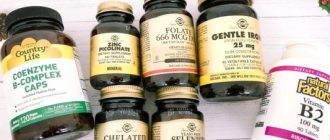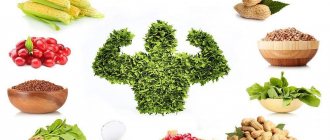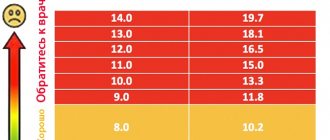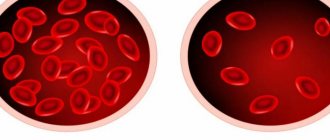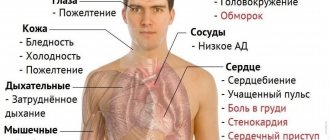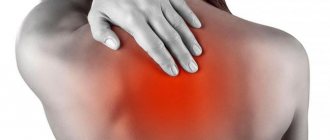Symptoms of low hemoglobin
Signs of iron deficiency anemia:
- darkening of the eyes, headaches;
- pale skin;
- lethargy, apathy, weakness;
- low blood pressure, shortness of breath, rapid heartbeat;
- chilliness;
- the patient wants to eat chalk and earth;
- massive hair loss;
- brittleness and thinning of nails.
Causes
The development of anemia during pregnancy and after childbirth is caused by several reasons:
- Sick iron consumption in the third trimester. During this period of development, the baby needs iron in large quantities, so the mother’s body begins to release the necessary vitamins, minerals, including iron.
- Large blood loss during childbirth, usually occurs during caesarean section.
- Diseases of the circulatory system, heart, various types of infections.
- Diet food or poor diet.
The most common cause of anemia is a strict diet. Most women who have given birth quickly want to return to their former shape, so they go on a strict diet. At the same time, they do not think that they are endangering their health and the baby. This can lead not only to the development of anemia, but also to exhaustion of the body.
Concomitant factors for the appearance of anemia after childbirth are stress, fatigue, bad habits (abuse of tea, coffee) and frequent childbirth (there should be a break of at least 3 years between pregnancies). In this condition, raising hemoglobin to the required level is much more difficult.
Some experts believe that the cause of iron deficiency anemia is an internal conflict in the body. This disease is more likely to affect women who suffer from a lack of care, attention, support and the fear of not being able to cope alone. Against this background, lethargy, weakness, headaches and darkening of the eyes appear. Thus, the body itself suppresses the woman so that she lies down and does not struggle with her problem.
According to Louise Hay, there are two psychosomatic causes of this disease:
- lack of self-confidence and low self-esteem;
- fear of life or complete lack of joy in it.
V. Zhikarintsev adds one more reason to this list - claims to the surrounding world.
Liz Burbo believes that blood is life itself. If a person has lost the taste for life, then this disease manifests itself. In confusion and ignorance, a person simply becomes lost and depressed, which negatively affects his health, including the functioning of the hematopoietic system.
Sh. Shalila and B. Baginski, famous healers, also believe that anemia is the result of a lack of joy.
A. Torsunov interprets this as follows:
“The human body, which tends to be sad and sad often, stops producing the required number of red blood cells. Passivity and pessimism lead to disruptions in the functioning of the circulatory system. But excessive fuss and overexcitement can also provoke this disease.”
Therefore, not only laziness reduces the activity of blood cells, but also passionate desires. Thus, the degree of activity of blood cells depends on the determination and positive attitude of a person. The more you enjoy and are satisfied with life, the more likely it is that your circulatory system will function properly.
Another example from Torsunov: it often happens that a child is unwanted, but due to circumstances, a woman carries it and gives birth. After giving birth, she falls into a deep depression - the child becomes a burden and a burden for her. Excessive fatigue and despair lead to the development of anemia. But if a woman enjoys motherhood, the number of red blood cells produced increases.
Iron-rich foods that are not recommended for breastfeeding mothers
Although some ingredients in our kitchen are rightfully considered very useful for increasing blood hemoglobin, it is better to avoid them during lactation - at least in the first couple of months after birth.
This recommendation from doctors can be explained simply - these products contain many allergens, and therefore, when feeding a newborn with breast milk, the mother should eat them with great caution. It is better to replace potentially dangerous ingredients from the list with approved ones in order to prevent the baby from developing an allergic reaction.
But if the baby is already six months old and is gradually starting to switch to complementary feeding, then the woman is allowed to try foods from the list below, but only while maintaining moderation.
If a child reacts normally to strawberries or cocoa, does not have a tummy ache after drinking mother’s milk and does not have red spots or stomach upset, then you can safely use this component as a preventive measure for iron deficiency anemia.
Dangerous and allergenic products to increase hemoglobin during breastfeeding
Grape
One hundred grams of grapes contain 0.6 mg of iron. However, such a product is often poorly tolerated by the baby’s tummy - after grapes eaten by a nursing mother, the newborn may experience intestinal colic or bloating.
Strawberry
This berry is considered one of the most allergenic and not very desirable in the diet of a young mother, despite the fact that it contains slightly more iron than grapes - 0.7 mg.
Chocolate
Real dark chocolate, prepared according to all the rules, is a real record holder for the amount of useful minerals - it contains as much as 11.7 mg of iron per 100 grams. But, like strawberries, in the first months after childbirth, such a dessert will be very undesirable during breastfeeding due to its allergenicity.
Cocoa
Cocoa powder is almost the same as chocolate, because your favorite dessert is made from cocoa beans. Therefore, along with its high iron content, cocoa is also an ingredient with a high risk of developing an allergic reaction.
Citrus
During lactation, lemons, oranges and tangerines eaten by a mother can cause serious complications in the body of her newborn. Since these fruits are traditionally classified as highly allergenic, they should not be consumed during the first months after the baby is born.
Honey
100 grams of bee honey contains 1.1 mg of iron. This value is classified as a product that is moderately beneficial for blood hemoglobin, and honey is rightfully considered an activator of the immune system. However, during lactation, this ingredient can be replaced with any other that will not cause an allergic rash in the infant.
How to deal with anemia
The first thing you need to do is adjust your diet. If you have no contraindications, drink freshly squeezed juices from beets, carrots, pomegranates and apples. They can be mixed or diluted with boiled water.
The most valuable sources of iron:
- pomegranate;
- amaranth and alfalfa sprouts;
- Jerusalem artichoke;
- green buckwheat;
- rye;
- legumes;
- chlorophyll from nettle leaves, leafy greens, beet and carrot leaves;
- Milk thistle meal.
Among vegetables, tomatoes, herbs, pumpkin, beets and green vegetables will help increase hemoglobin. Fruits that contain large amounts of iron are quinces, peaches, apples, plums, apricots, persimmons and pears. Berries in the diet should include currants, cranberries, strawberries, strawberries and blueberries.
Healthy recipes
There are several recipes that will help restore iron levels in the blood:
- Pour a glass of boiling water over 4 clover flowers, an hour after steeping, strain. Take ½ glass three times a day on an empty stomach for 30 days.
- Take a glass of walnut kernels and green buckwheat, chop in any convenient way, add honey, stir. Take 1 tbsp daily. l.
- Mix aloe leaves ground in a meat grinder with honey in equal quantities. Close the lid tightly and keep in a dark place for 5 days. Take 1 tbsp. l. in the morning, at lunch and in the evening before meals every day until you use it up.
- Make a mixture of honey, prunes, dried apricots and raisins - 500 g of each component. Take 3 tbsp. l. per day for a month. Mix dry nettle leaves with pollen and natural honey in a ratio of 3:1:2. Take 1 tsp. on an empty stomach half an hour before meals, washed down with water.
- You can increase hemoglobin using chyawanprash.
- Take 1 tsp on an empty stomach. milk thistle with a small amount of water.
For better absorption, iron must be taken with vitamin C (ascorbic acid), as well as preparations or products containing copper, zinc and manganese. These include tomatoes, lettuce, raisins, spinach. Some vegetables and fruits contain a complex of essential substances - iron and components that promote its absorption.
To increase hemoglobin, it is useful to take a long walk in the fresh air and give the body moderate physical activity, for example, yoga, swimming under water.
In addition to proper nutrition, it is necessary to reconsider your views and beliefs: a positive and optimistic person is less susceptible to this disease.
Products to increase hemoglobin during breastfeeding
We offer you a list of the ten most iron-rich foods that are allowed in the diet of a nursing mother. Using them daily in your menu, you will be able to increase hemoglobin and get rid of the typical signs of incipient anemia - headaches, drowsiness and increased fatigue.
Pork liver
29.7 mg iron per 100 grams of product
It is best to steam pork liver - this way the beneficial substances are better preserved and the valuable iron is not destroyed during heat treatment. If you include this product in your menu and eat it only a few times a week, you can forget about anemia for a long time.
Dried apples
15 mg iron per 100 grams of product
Dried fruits are both a healthy dessert for increasing hemoglobin and for strengthening overall health. Dried apples are a natural source of iron and potassium, magnesium and sodium, as well as calcium.
Dried pears
13 mg iron per 100 grams of product
Pears are another fruit that is safe for the body of a nursing mother and her baby. If you don’t like chewing dried pieces, then simply fill them with hot water and let them brew in a thermos. The result is an aromatic drink with a pleasant taste - a real vitamin cocktail.
Prunes
13 mg iron per 100 grams of product
Prunes are useful both for the prevention of iron deficiency anemia and for the digestive system of a young mother. It is no secret that after childbirth and during lactation, women suffer from constipation - an unpleasant condition and a delicate problem caused by the fact that most of the minerals and fluids are converted into breast milk. Prunes cope well with this situation and at the same time increase the level of hemoglobin in the blood.
Dried apricots
12 mg iron per 100 grams of product
Dried fruits are the largest category of foods that are allowed during breastfeeding and are rich in iron. You can enhance the effect of dried fruit if you soak it in warm water for a couple of hours, then drain the liquid, finely chop the fruit and add it to the cottage cheese. This dish allows iron to be better absorbed due to the presence of a large amount of calcium.
Rose hip
11 mg iron per 100 grams of product
Rosehip teas and decoctions are useful for various diseases, as this plant strengthens blood vessels and heals internal systems, improves immunity and lowers blood pressure.
During lactation, you can prepare yourself weak vitamin teas from rose hips - in addition, they are also useful for the activity of the mammary glands.
Beef liver
9 mg iron per 100 grams of product
It is best to cook beef liver according to the same principle as pork liver. But unlike pork, beef offal is considered a more dietary product, which has much lower calorie content and is better absorbed. In addition, cow liver is rich in animal protein, a substance important for human health.
Beef kidneys
6 mg iron per 100 grams of product
If you have a normal attitude towards offal dishes, then instead of ordinary beef or veal, you can cook kidneys. They can be stewed, steamed or boiled, combined with buckwheat. Such a lunch will not only be satisfying and low-calorie, but will also effectively increase the level of hemoglobin in the blood of a nursing mother.
Oatmeal
5 mg iron per 100 grams of product
Oatmeal is traditionally called barley or oat flour - it is much healthier than wheat, and it contains a large supply of iron, as well as manganese, zinc, phosphorus and magnesium. Oatmeal porridge will be an excellent addition to the menu during breastfeeding.
Egg yolk
5.8 mg iron per 100 grams of product
Boiled chicken eggs are a low-calorie product due to the protein shell and healthy due to the yolk. To replenish the body's daily need for iron, it is enough to eat three chicken yolks.
As you can see, foods that increase hemoglobin during breastfeeding are a fairly extensive list, which includes fruits, meat, and even cereals. Spinach, lamb, apricots, pumpkin and oatmeal are also very rich in iron.

